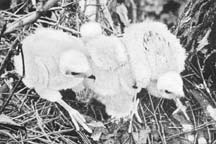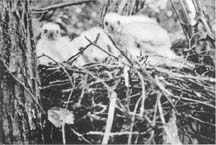THE CHICKEN THIEF
page 45 GETTING THE EVIDENCE AGAINST MR. COOPER HAWK AND HIS FAMILYTommy Jones was losing his chickens; there was no question about that, and
Tommy was very much disturbed by the occurrence. Mrs. Tommy had started the incubator very early that spring and had kept it going. She had also utilized every setting hen, with the result that the back yard was fairly overflowing with chickens. Nearly every night there would be one or more missing. Sometimes there would be as many has three less when they shut them up at night than when they were released in the morning. When Tommy watched Father Red-tail soaring high overhead in the summer sky, he remembered the day when the Naturalist had been confronted with absolute proof that the Red-tails were chicken thieves, and sputtered about his neighbor and the chicken hawks. If Father Red-tail happened to be in sight at the time when new losses were discovered among his chickens, his feelings nearly overcame him. On such occasion, if opportunity offered, he was very free to tell the Naturalist, in language more forceful than eloquent, just what he thought of him and his hawks.This time the Naturalist was not entirely above reproach, for he had a secret. He knew the thief and knew where the stolen birds were served daily at dinner. The Naturalist was not in sympathy with the thief, but he was anxious to learn the real facts concerning the habits of an undesirable family of neighbors and was patiently watching them to find out. Besides, if Tommy Jones had used his eyes to good advantage he might have known also.
Mr. and Mrs. Cooper Hawk, like criminals generally, were very shy in their movements. While they fed daily from the poultry yards of the neighborhood, few persons ever saw them come, and when they were seen their movements were so swift that the observer had but a confused idea of the bird he saw. Tommy Jones was not the only one who charged the Red-tails with the theft of the chickens taken by the Cooper Hawks. While Father and Mother Red-tail soared high over the fields in search of gophers the Cooper Hawks kept to the cover of the woods.
When all was quiet in the farm-yard and the farmer and his family were within doors, Cooper Hawk would silently alight on some object which furnished a view of the poultry yard. When a favorable opportunity offered he would dash in pursuit of an unfortunate chicken, and, seizing it, fly away so swiftly as to offer little chance of pursuit. Safe in the shelter of the woods he would make a meal at his leisure. The Naturalist, being familiar with their habits, often observed them in their raids, while Tommy Jones and his neighbors swore at Father Red-tail soaring afar in the upper air.
The Naturalist had heard the shrill call, used only in the nesting season, many times before he was able to locate the nest. The location chosen was as far from a house as could well be found in that thickly settled neighborhood. It was placed under the sheltering leaves of a heavy growth of Virginia creeper, in a walnut tree, thirty-five feet above ground. The tree grew near the river about half a mile from the nearest human habitation. So cleverly was it hidden from sight that even after the Naturalist had discovered its location, he could scarcely see it from the ground.
It was on June 8 that he first climbed the tree and examined the nest. The structure was about the size of a crowís nest but composed of much smaller twigs. Most of the twigs used were not larger than those used by the wren in making her home, and few of them were as large as a lead pencil. There was only a slight depression in the center of the nearly flat nest and no lining, excepting a few scales of bark. In the nest were three white eggs with a slight bluish tinge. Evidently incubation had been in progress several days, for all three eggs hatched on June 20, only twelve days later, and most authorities give twenty-four days as the period of incubation of the cooper hawk.
When the Naturalist undertook the task of making a photograph of the nest and eggs, he found that it was no easy task. It was not difficult to reach the site, but there was no limb on which to stand nor any suitable support within reach on which to place the camera. Accordingly, after trying various schemes without result, he strapped himself to the body of the tree immediately above the nest and, with both hands free to manipulate the camera, secured the picture shown herewith.
The situation was not very satisfactory, as the outline of the nest could not well be shown directly from above and at such close range. After the eggs had hatched, he made several attempts to get a satisfactory photograph of the young in the nest from a different location. Making pictures so high from the ground is rather unsatisfactory at best, since one does not care to fall even thirty-five feet, and one has not much margin for work with his body strapped tightly to a tree. After several attempts, a picture of the young birds peering over the nest was secured, although at too close range to give a proper impression of conditions. The ends of the twigs composing the nest were so much nearer the lens than were the birds, that they appear much larger in the picture than they were in fact. After working with little satisfaction to get a picture from other points, he again climbed to the place above the nest where he had made his first attempt, and made an exposure looking directly down upon them.

When the young first appeared in the nest, they were covered with white down that gave them something the appearance of little ducks. When the first feathers began to show through the down, they were eighteen days old, and it was at that time that the picture was taken. From this time on, the birds grew very fast, and a great change could be noticed in their appearance from day to day. Ten days later they were nearly fledged and beginning to threaten to leave the nest. At times they would walk out on the limbs of the tree as though preparing for flight.
During these days the Naturalist was making daily visits to see how the birds grew, and also to see what became of Tommy Jonesís chickens. The parent birds were very shy, and usually left as quickly as possible on his approach. Father and Mother Red-tail, on the other hand, remained close at hand, anxiously watching, whenever he visited their nest. Mother Sparrow Hawk at times refused to leave her young when newly hatched, even when he approached within two feet of her. Mother Screech Owl had even permitted him to lift her from the nest when her babies were little, and attacked him furiously after he had released her, but neither Mother nor Father Cooper Hawk would take any chances on remaining to see what happened when he visited their nest. He was never able to approach very near the nest without his presence being detected, and the most he could get, as a rule, was a fleeting glimpse, through the trees, of a swiftly flying bird. The few times when Mother Cooper Hawk did remain she kept herself hidden among the leaves and not very near at hand.
He did not find it an easy matter to determine their menu. The Sparrow Hawk family left the fragments of their dinner in the nest so that he easily determined daily what they were eating. The Red-tail family seldom failed to leave a partly eaten carcass, or at least feet and tails at hand, to show on what they had dined, but the Cooper Hawk family were skilled in removing every trace of incriminating evidence. Seldom did even a feather remain, and never the usual fragments of legs and other appendages.
GETTING AT THE MENU
After trying for several days to see the mother bird in the act of feeding her young, or to find some trace of partly eaten food which would give reliable information concerning their habits, he decided that there was but one way to get results--to visit the nest frequently, and whenever they had recently been fed to compel them to disgorge their dinners in the interest of science. This proved to be a disagreeable task, but it was followed faithfully for many days. While rather unpleasant business, it had the great advantage of making an accurate determination possible in many cases. At times the mutilation was so great that the species could not be easily determined with certainty in the case of small birds.
It soon became apparent where Tommy Jonesís chickens were going. During the first few weeks of the observation no evidence of any food other than poultry, pigeons, or birds was found. Breakfast, dinner or supper, it was spring chicken, pigeon, or quail. Of course, the diet was varied with such delicacies as robin, flicker, or thrush, but such commonplace food as mice and gophers was spurned. Chicken, being the most easily available, was perhaps more often served than any other single item.
When it comes to supplying six to a dozen chickens a week to a family of hawks, even a large flock soon shows the effects, and the Naturalist did not wonder that Tommy was on the warpath. When finally the Naturalist told Tommy about the nest and the daily menu, his indignation knew no bounds. What he thought of the Naturalist is better imagined than told. Still he refused to be convinced that the Red-tail family had not been equally guilty. About the first week in July the farmers were putting up they hay and harvesting their small grain. By the 12th the fields were clean, and the ground squirrels could be seen everywhere scampering about. Ground squirrel now became for a time a favorite article of diet. However, seldom did more than a day elapse without a chicken being served in proper Cooper Hawk style, even then. The prairie gray squirrel (Franklinís spermophile) and the striped ground squirrel were the only small animals that the Naturalist knew them to take. In fact, no insects or reptiles or other small animals, as far as he could tell, entered into the diet.
When the first of the three young birds left the nest it was captured, and together with the other two taken to the home of the Naturalist, where they were placed in a large cage. Their food from that time on consisted of raw meat, mostly beef scraps. They did not seem to get on well, even with each other, and apparently their appetites were not satisfied without a mixture of feathers with their meat. At any rate, two of the birds finally killed and ate the third one. In all his experience with birds the Naturalist had never seen a family where there was such an entire lack of interest in the young on the part of the parent birds. Some birds that are extremely shy are very solicitous concerning their young, but like some human criminals, self-preservation seemed to be the only thing that greatly concerned the cooper hawks.
Next Chapter
Book Contents
Return to Bob' Page
